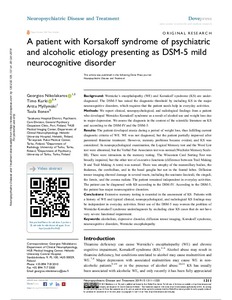A patient with korsakoff syndrome of psychiatric and alcoholic etiology presenting as DSM-5 mild neurocognitive disorder
Georgios Nikolakaros; Tuula Ilonen; Arttu Myllymäki; Timo Kurki
https://urn.fi/URN:NBN:fi-fe2021042823531
Tiivistelmä
Background: Wernicke’s encephalopathy (WE) and
Korsakoff syndrome (KS) are underdiagnosed. The DSM-5 has raised the
diagnostic threshold by including KS in the major neurocognitive
disorders, which requires that the patient needs help in everyday
activities.
Methods: We report clinical,
neuropsychological, and radiological findings from a patient who
developed Wernicke-Korsakoff syndrome as a result of alcohol use and
weight loss due to major depression. We assess the diagnosis in the
context of the scientific literature on KS and according to the DSM-IV
and the DSM-5.
Results: The patient developed ataxia
during a period of weight loss, thus fulfilling current diagnostic
criteria of WE. WE was not diagnosed, but the patient partially improved
after parenteral thiamine treatment. However, memory problems became
evident, and KS was considered. In neuropsychological examination, the
Logical Memory test and the Word List test were abnormal, but the Verbal
Pair Associates test was normal (Wechsler Memory Scale-III). There were
intrusions in the memory testing. The Wisconsin Card Sorting Test was
broadly impaired, but the other test of executive functions (difference
between Trail Making B and Trail Making A tests) was normal. There was
atrophy of the mammillary bodies, the thalamus, the cerebellum, and in
the basal ganglia but not in the frontal lobes. Diffusion tensor imaging
showed damage in several tracts, including the uncinate fasciculi, the
cinguli, the fornix, and the corona radiata. The patient remained
independent in everyday activities. The patient can be diagnosed with KS
according to the DSM-IV. According to the DSM-5, the patient has major
neurocognitive disorders.
Conclusions: Extensive
memory testing is essential in the assessment of KS. Patients with a
history of WE and typical clinical, neuropsychological, and radiological
KS findings may be independent in everyday activities. Strict use of
the DSM-5 may worsen the problem of Wernicke-Korsakoff syndrome
underdiagnosis by excluding clear KS cases that do not have very severe
functional impairment.
Keywords: alcoholism,
depressive disorder, diffusion tensor imaging, Korsakoff syndrome,
neurocognitive disorders, Wernicke encephalopathy
Kokoelmat
- Rinnakkaistallenteet [19250]
